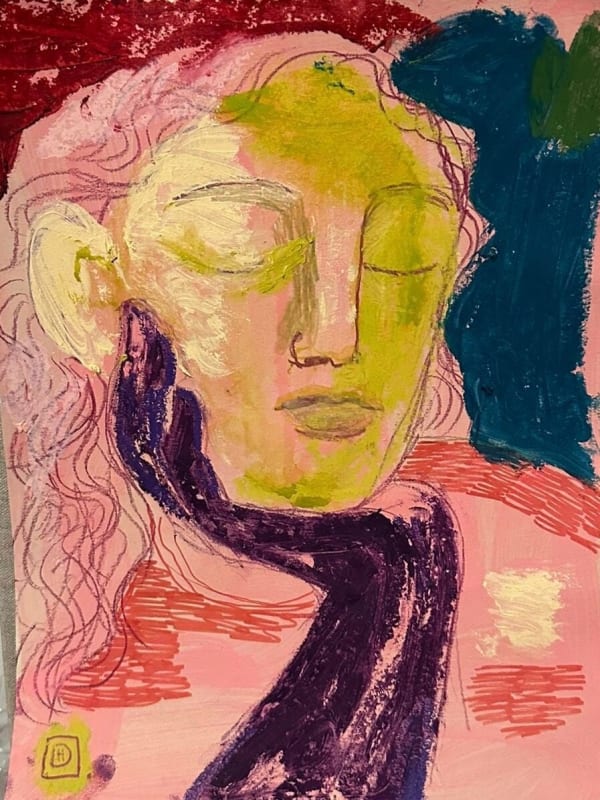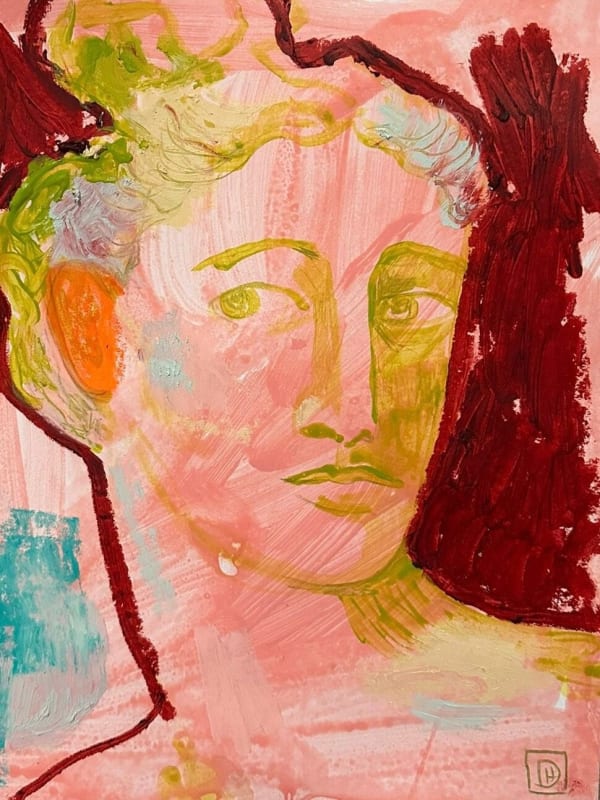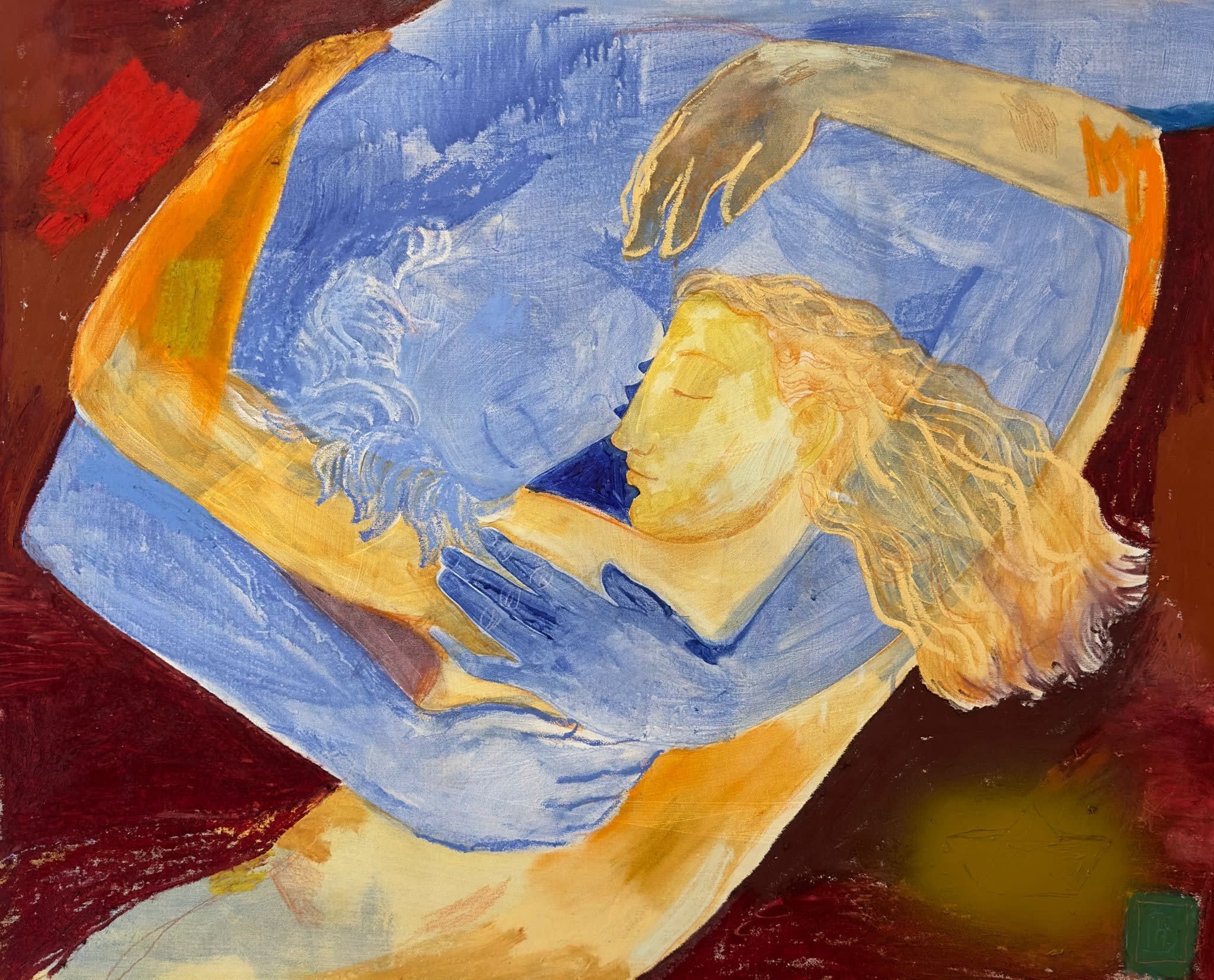-
FOREWORD
Delia Hamer’s artistic journey is one marked by a rich interplay of geographical influences, personal exploration, and a deep connection to mythology and religion. Born in Germany and raised in the sun-drenched landscapes of southern Spain, Hamer’s early surroundings seep into her paintings, with their vibrant color palettes and recurring motifs like palm trees, agaves, and terracotta vases.
Her paintings, often featuring solitary female figures, delve into themes of vulnerability, rawness, and solitude, inviting the viewer to reflect on their own experiences and connections to the human soul. These dreamlike scenes echo a retreat to a forgotten time—a conscious return to a personal Eden where the boundaries between myth, memory, and identity blur.
What I particularly admire about Delia’s work is her ability to blend strength with vulnerability, creating compositions that are both visually arresting and emotionally resonant. There’s a delicate tension between the rawness of her figures and the lush, dreamlike landscapes that envelop them. Each piece feels like an invitation to slow down, to reflect, and to connect with something universal yet deeply personal. Her exploration of solitude, not as loneliness but as a conscious retreat into a space of introspection, is something that resonates profoundly with me.
This interview was a wonderful moment to dig deeper into the artist’s universe, as it gave me a better understanding of the motivations and emotional layers behind Delia’s stunning creations. There is a unique depth that comes from hearing directly from the artist, as it transforms the way we engage with the artwork. Understanding the intentions and personal narratives behind each piece enriches the experience, allowing us to see the work through a more nuanced lens. Delia radiates a vibrant energy, wit, light, and enthusiasm—qualities that are not only central to her character but also weave through the very fabric of her artistic practice. It was such a pleasure to interview Delia, an artist whose work I deeply admire and find incredibly inspiring.
-Soraya.
-
 The artist in her studio | Photo credits: Delia Hamer's website
The artist in her studio | Photo credits: Delia Hamer's website -
THE INTERVIEW
S: “Can you tell me about yourself?”
DH: "I earned my bachelor's degree in painting, which I started when I was 18. I moved to Milan in September to study at the Academy of Brera, which had a strong connection to the spirit of arte povera. However, my paintings didn’t align with that movement at all, and I often felt like I didn’t quite fit in. That disconnect made it difficult for me to develop my own visual language during my time there. For a long time, I even doubted if I had a future in the arts because the way I wanted to paint wasn’t well received. While my studies didn’t necessarily help me find clarity in my artistic direction, they did offer some valuable experiences. For example, I took courses that genuinely interested me, like anatomy. Learning about the body and its structures gave me the technical skills to approach the human figure in my work, which has been invaluable. Ultimately, I developed my visual language entirely after my studies. It was a process of finding my own path once I stepped outside the academic framework, which didn’t quite align with my vision."
S: “What is the most valuable lesson you’ve learned during your art studies, and conversely, is there something you were taught that you now actively seek to deconstruct or modify in your current practice?”
DH: "I completed my BA in painting in three years, but by the end of it, I felt very confused about my direction. So, I decided to take a gap year to step back and reassess things. That time away was crucial—it helped me reconnect with my love and passion for creating and painting. During that period, I realized my inclination had always been towards the figurative, which led me to pursue a master’s in illustration in London. I saw illustration as a safer, more structured path. However, as I worked through that program, I found myself drawn back to painting and the creative freedom that being an artist offers—something a career in illustration didn’t quite provide. Eventually, I decided to move to Lisbon to give myself the time and space to absorb all of these experiences. That move was about rediscovering who I was as an artist and letting everything I’d learned shape my next steps."
S: “Do you feel that your artistic training has adequately prepared you to navigate the art market, both in terms of your practice and potentially professional relationships as well?”
DH: "No, absolutely not. I always had this underlying feeling that school wasn’t the right environment for me. I felt a strong need to isolate myself—to step away from the world of creation, artists, and professors. For my work to have real strength and longevity, it had to come from within me, not from external influences. I didn’t want to just experiment aimlessly or dabble in things without a deeper purpose. I made a conscious decision to avoid looking at art for a while to ensure my ideas weren’t ‘contaminated.’ It was about giving myself the space to discover my own voice and vision, free from outside pressures or expectations."
S: “When was art introduced into your life?”
DH: "My connection to art began very early, shaped by both emotional and academic influences. On the emotional side, a big part of it stems from my uncle, who tragically passed away at just 19. He was the only one in the family who painted, and that was his greatest passion. After his death, my mom always nurtured this idea that while he couldn’t live out his dream, I could live out mine—or even his. That sense of interlinked destinies has always stayed with me, and it’s a big reason why my mom was so supportive of my artistic pursuits. On the academic side, my mom also cultivated a deep interest in art in our family. Whenever we traveled, she made a point of taking us to major exhibitions and exposing us to different art forms and histories. That blend of emotional connection and intellectual curiosity really laid the foundation for my journey as an artist."
S: “What was the first artistic experience or work that truly struck you like a coup de foudre?”
DH: "I was about 13 or 14 when my mom took me to the Uffizi Gallery in Florence. Being surrounded by the works of the masters was such a powerful experience—we spent hours there. I’ll never forget what happened as we were leaving. I walked out and started having a full-on nosebleed, right there at the exit of the Uffizi. It was as if I’d been both emotionally and physically struck by everything I’d seen. That moment really stayed with me. It was the first time I realized how deeply art could affect you, not just as something you appreciate, but as something that takes a toll on you in the best way. Botticelli, in particular, left a lasting impression on me. I have such a deep love for his work—the way he draws and creates resonates with me profoundly, and you can still see his influence in my own art. That experience at the Uffizi taught me just how powerful a passion for art could be—something that’s beautiful but also intense enough to overwhelm you."
S: “Your work speaks a lot to women. Why is that according to you?”
DH: "During the four to five years I spent in Lisbon, I focused exclusively on painting female figures. That period was deeply tied to my own self-discovery and identity exploration. Painting women felt like a natural extension of that journey—an intimate way to reflect and understand myself. It’s only been in the past two years that I’ve started painting male figures. Initially, they appeared alongside female figures, almost as secondary characters. But more recently, the male figure has become a protagonist in his own right. It’s been an exciting shift, and it feels like a new chapter in my work, expanding the stories I want to tell and the perspectives I want to explore."
-
S: “Your depiction of solitude, rather than loneliness, in female figures feels deeply intentional. How do you think this theme resonates with contemporary audiences?”
DH: "There’s a clear intention in my paintings to encourage a moment of pause—to breathe, look inward, and reflect. It’s not about the material world outside but rather the nature within us. Over the years, as I’ve continued painting, I’ve become more aware of certain peculiarities or boundaries in my practice—what I might even call blockages. For instance, I have an innate resistance to shrinking or enlarging the human figure. For me, the figure must always be life-sized. That scale creates an immediate connection between the viewer and the subject, making the interaction more direct and personal. I also don’t use photographic references or draw from life; everything comes from my imagination. This process creates landscapes of the mind, with shifts in space, a lack of traditional depth, and a juxtaposition of elements that feel almost dreamlike. The faces in my work remain blank—a deliberate choice. Without facial expressions, the figures exude a sense of solitude, tranquility, and serenity. It allows viewers to project their own emotions onto the painting, creating a more universal connection. I avoid anchoring my paintings to a specific time or place. By steering clear of manmade objects, I create spaces that feel mythological—timeless and removed from the everyday. These choices reflect my interest in exploring something more internal and eternal, inviting the viewer to step into a world of reflection and stillness."
-

Delia Hamer
TENDERNESS MAY SAVE US 4, 2024Acrylic and mixed media on canvas
75 x 87 cm -
S: “What’s the most personal piece you have ever done?”
DH: "Il Ballo de la Vita (2023) is one of my most personal works to date. I usually aim to create paintings that allow viewers to connect on a broad, universal level by intentionally leaving out too many specifics. But with this piece, I broke my own rules. The woman in the painting has a rounded belly—a clear reflection of myself at the time, as I was pregnant when I created it. That detail makes the work deeply personal and different from much of my other work. While I typically avoid including autobiographical elements, this piece became an intimate expression of a transformative moment in my life. It feels like a celebration of creation, not just in the artistic sense, but also in the very literal, human sense."
-
 Il Ballo Della Vita (on the right) | Photo credits: Alizée de Vanssay
Il Ballo Della Vita (on the right) | Photo credits: Alizée de Vanssay -
S: “Dreamscapes and forgotten times are recurring elements in your art. How do you balance the universality of these themes with the deeply personal memories and circumstances they are rooted in?”
DH: "That’s just my modus operandi—almost all of my paintings are rooted in personal narratives. They reflect what my soul is experiencing and what I’m going through at any given moment. My art is how I process those experiences, using my visual vocabulary to explore and express them. But my intention is never just to depict my personal reality. I aim to reveal the layer behind it—the deeply human experience that underlies it all. By translating these personal moments into something universal, I hope to create a space where others can see and feel their own stories within my work."
S: “Your focus on vivid colors and impassive nudes creates a sense of both power and detachment. What role do you see color playing in the emotional impact of your work?”
DH: "Color is a huge element of my work. I always begin a painting by thinking about two colors—usually complementary ones, like red and blue or green and red. These colors set the tone and dominate the composition, acting as the foundation for everything else, including the major protagonists in the scene. I use color as a kind of hook to draw people in. That’s why I gravitate toward bright, striking hues—I want the image to captivate the viewer immediately. For me, color isn’t just decorative; it’s an essential tool for creating a strong emotional connection with the audience."
-

Delia Hamer
Nispero Tree, 2024Oil on canvas
222 x 195 cm -
S: “Looking back on your career so far, what would you consider to be the most defining moment in your artistic journey?”
DH: "There are two key moments in my artistic journey that are deeply tied to geographical moves. The first was when I moved to Lisbon. It was a conscious decision to create space for my painting, to expand both my world as an artist and my inner self. I wasn’t sure what would happen, but thankfully, it allowed my work to evolve, grow, and truly surge. Those years in Lisbon marked my 'coming to maturity'—a period of self-discovery, both on and off the canvas. The second moment came when I moved to Amsterdam. I arrived in August, and by September, I was contacted by Paul, the founder of MAĀT Gallery, who suggested I do a solo show in February. That collaboration with Paul was a pivotal moment for me—it felt like a real high in my career, a significant step forward."
-
 FLUYE SIN CESAR, the artist's solo show (2023) | Photo credits; Alizée de Vanssay
FLUYE SIN CESAR, the artist's solo show (2023) | Photo credits; Alizée de Vanssay






